|
|
|
 |
 |
|
Arctostaphylos columbianna
Manzanita
Southern British Columbia to Sonoma County, California
Family Ericaceae
Native
Manzanita, Spanish for little apple, grows in dry, sunny spots at low elevations and is common between the Capes, especially in disturbed or logged area where it is a secondary colonizer. Bushes may be up to ten feet tall with smooth and peeling reddish brown bark, and oval to lance-shaped, evergreen leaves that are covered top and bottom with minute hairs. The flowers, growing in terminal clusters, are pinkish to white and urn-shaped. The fruit, rusty-red berry-like drupes, are edible but mealy. They are said to cause constipation, though the bark of the shrub has been used to treat diarrhea. The beautiful reddish bark and exotic, gnarly shape of the bush makes manzanita a favorite natural landscape plant.
|
 |
 |
|
Arctostaphylos uva-ursi
Kinnikinnick or bearberry
Throughout North America except some Mid-western and Southern States
Family Ericaceae
Native
Kinnikinnick is a low-growing, woody perennial shrub of the same genus as manzanita. It is native to North America and Eurasia. A few small plants are present between Netarts and Oceanside, but it is very common on Netarts Spit. It is also planted as a ground cover in the Capes development.
Kinnikinnick is an Algonquian word which means "that which is mixed" or "smoking mixture". Dried leaves and sometimes the bark blended with tobacco, which was native to the eastern Americas, were smoked in pipes or tubes by native peoples for ceremonial and social reasons. West Coast tribes, including the Killamooks, lacked tobacco before the white man began trading and settling, so they smoked kinnikinnick straight. Author Don Berry, in his historical novel of Elbridge Trask, one of the first settlers along Tillamook Bay and for whom the Trask River is named, wrote an account of the Killamooks smoking kinnikinnick at a council meeting.
Kinnikinnick has light pink, urn-shaped flowers and dark green, obovate leaves that are shiny on top and connected to the stem at the narrow end. They are said to have diuretic properties and were used by some coastal peoples, and by Europeans since the sixteenth century, for kidney and urinary problems. The fruit is a bright red berry about the size of a small grape. The species epithet uva-ursi means bear grape, and the fruit is eaten by black bears in our region. Meriwether Lewis described the berry as "a very tasteless insipid fruit". He was right. They are tasteless and mealy with large seeds.
You may notice occasional bright red swellings on the leaves of kinnikinnick. These are galls induced by the manzanita leaf-gall aphid Tamalia cowani. Feeding by the aphid on leaf juices, especially in new growth, stimulates kinnikinnick to form the galls (Photo of the aphids was taken by Dr. John DeMartini, Humboldt State University).
|
 |
 |
|
Armeria maritima, subsp. californica
Sea pink, sea thrift
British Columbia to California
Family Plumbaginaceae
Native
Sea pink is a perennial that can be found in the upper levels of the salt marsh at the southern end of Netarts Bay, usually in sandy areas without a lot of competing vegetation. It usually blooms in mid June. Pink, papery flowers are clustered into a terminal head on a single stem that is subtended by an involucre of broad bracts. Two of the bracts unite and extend downward to form a sheath around the upper part of the stem. The leaves are long, narrow and basal. There are a couple of subspecies; subsp californica is mainly a coastal.
|
 |
 |
|
Cakile edentula
American sea rocket
Alaska to California, many Eastern and Southern States
Family Brassicaceae
Native
Cakile maritima
European sea rocket, horned sea rocket
British Columbia to California, some Eastern and Southern States
Family Brassicaceae
Non-native
Two species of sea rocket, the American Sea Rocket (Cakile edentula) and the introduced European Sea Rocket (Cakile maritima) inhabit hummocky sand along our sandy beaches above the high tide line. They are two fleshy, rather sprawling, seashore annuals with four-petal flowers. You may find them growing separately or intermingled with each other. The leaves of the American Sea Rocket are sinuate to lobed and broader that those of its European counterpart whose leaves are parted, that is deeply lobed almost to the midrib. The flowers of the American variety are miniscule, whereas the flowers of the European Sea Rocket are large, maybe a centimeter across, pink, and showy. Both bloom in June and July, but you may see flowers on the European Sea Rocket into October. The fruits of both are siliques, paired seed capsules separated by an internal septum, with two vertical segments, the upper segment larger than the lower one. The silique of the European Sea Rocket has two projections at the joint. These are lacking in the American species. According to Pojar and MacKinnon, the American Sea Rocket may have been introduced from the East Coast. Pictured are C. edentula (left) and C. maritima (right) with their respective flowers and fruits below the plants.
|
 |
|
|
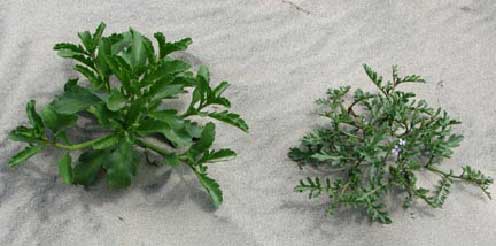 |
 |
 |
|
Cakile edentula Cakile maritima
|
 |
 |
|
Castilleja affinis subsp. litoralis
Pacific or Seashore Paintbrush
Washington to Central California
Family Scrophulariaceae
Native
This perennial paint brush, also coastal, can be found in the dunes at the northern end of Netarts Spit and along the trails at Cape Meares. It has a purplish stem and lance-shaped leaves. Calyx lobes are rounded, and the bracts are bright red. Small, unbranched hairs cover the stem and bracts. It can be found May through July in our area.
|
|
|
 |
 |
|
Centaurium erythraea
Common centaury, European centaury
British Columbia to Northern California
Family Gentianaceae
Non-native
This European introduction, which is either an annual or biennial, can be found blooming during June and July in the dunes near the end of Netarts Spit. Its flowers, borne in clusters, have bright pink, five-lobed corollas and yellow stamens projecting from the centers. Leaves are sessile and opposite, each with three distinct veins. There is a rosette of leaves at the base of the plant. These basal leaves distinguish C. erythraea from C. muehlenbergii, which may also grow in our area but usually in moist forest.
|
|
|
 |
 |
|
Cirsium edule
Edible thistle, Indian thistle
Alaska to Oregon
Family Asteraceae
Native
There are several easy ways to recognize this thistle. The stems are pubescent (hairy), the leaves clasp the stems but do not extend downward to form spiny wings as they do in the bull thistle, and the styles project from the corollas. It also has a tap root, whereas the bull thistle has rhizomes. When young, the flower heads often nod. The plant is a biennial or perennial native to western Oregon. Roots and young shoots were eaten by Native Americans.
|
 |
 |
|
Cirsium vulgare
Bull Thistle
Alaska to California, North America, Europe
Family Asteraceae
Non-native
Bull or the common thistle, another European import usually considered a pesky weed that thrives in disturbed areas, can be found on the bluff slope above the beach. The flower heads are attractive magenta disk and ray flowers (not distinguished from each other), with a base composed of overlapping, spine-tipped, involucral bracts. The alternate leaves are irregularly and deeply lobed, and are adorned with sharp spines which we try to avoid when near the plant. The bases of the leaves are decurrent, that is they extend downward along the stem and form wings, making the stem appear that it also has spines. Bull thistles reproduce by seeds only, each seed topped by a loosely attached, feathery pappus, the thistledown, which allows the seed to drift with the wind. These thistles are found all over North America and Eurasia.
|
 |
 |
|
Convolvulus soldanella (also Calystegia soldanella)
Beach morning glory
British Columbia to California
Family Convolvulaceae
Native
The beach morning glory, also called the beach bindweed, grows only on the coast and has none of the odious disrepute of the orchard morning glory, though it does twine around and bind other plants (the genus comes from the Latin “convolvo”, meaning to roll around). The flower is pink, sometimes with white stripes in the corolla. Its base is subtended by two bracts. The leaves are fleshy and reniform (kidney-shaped). It is a low, spreading vine with rhizomes a couple of inches below the surface of the sand that support aerial stems. You can find the beach morning glory on our upper beaches, often with its flowers twisted tightly in the cool of the morning.
|
|
|
 |
 |
|
Digitalis purpurea
Fox glove
Alaska to California, other Western States, Northeast.
Family Scrophulariaceae
Non-native
Introduced from Eastern Europe, this summer-blooming biennial can be seen along the roadside on the east side of Netarts Bay. Its magnificent, deep pink (sometimes white) flowers are arranged in a terminal raceme, each flower originating from a leaf axil. The axils with their flowers can be on any side of the stem, but some of the flowers bend around so they are all face one side of the stem. The petals are fused into an inch-plus long tube, flaring at the open end with a protruding lower lobe. There are four anther-bearing stamens. Sepals are separate, not fused. Leaves are hairy and largest in a whorl at the base of the stem. The plant may grow to six feet high.
All parts of the fox glove are highly poisonous. The plant produces cardiac glycosides that can cause death when ingested. However, these same cardiac glycosides are contained in Digitalin, a group of pharmacologically active compounds used for the treatment of heart conditions, and introduced by the English physician William Withering in 1785.
|
|
|
 |
 |
|
Epilobium angustifolium
Fireweed, willow herb
Alaska to Northern California
Family Onagraceae
Native
Also placed in two other genera Chamaenerion and Chamerion, fireweed or willow herb is a member of the evening primrose family and commonly grows in patches in cleared, well-drained soil along roadsides, in clearings, and especially in burned areas from which it is given its common name. It has alternately arranged lanceolate leaves with smooth margins. Its tall, magenta terminal spikes of four-petaled and four sepaled flowers paint a swath of brilliance during mid summer along the hillside just above the beach on the south side of Oceanside. There are also patches along the east side of Netarts Bay and along the highway just above Happy Camp. Young shoots can be eaten like asparagus, and its leaves, rich in vitamin C, make a passable tea. Beekeepers seek it out for the rich golden honey that bees make from its nectar. Early Native Americans twisted the outer layers of stems into cordage. Its fruits are capsules that discharge fluffy white seeds used as stuffing for mattresses and blankets by Native Americans and pioneers.
|
 |
 |
|
Epilobium ciliatum
Purple-leaved willow flower
Most of the United States (except some Southern States), Most of Canada
Family Onagraceae
Native
Related to Fireweed, Purple-leaved Willowherbs (probably Epilobium ciliatum subsp. ciliatum) are shorter plants with their magenta flowers arranged in small clusters near the ends of stems. They have wider but still lanceolate leaves that are finely toothed along their margins and long, four-sided capsules covered with minute hairs. These plants like moist, open sites and can be seen growing just south of Oceanside at the bottom of the hillside, near the fresh water seeps. There are three subspecies: subsp. ciliatum, subsp. watsonii, and subsp. glandulosum. To view their respective distributions, see http://plants.usda.gov/java/profile?symbol=EPCI.
|
 |
 |
|
Erigeron glaucus
Seaside Daisy
Oregon to California
Family Asteraceae
Native
This small perennial daisy grows mainly on coastal bluffs, often in rocky crevasses. It has light lavender to violet ray flowers and yellow disk flowers. Its leaves are entire, spatulate, slightly notched, and slightly succulent. Clatsop County, just to the north of us, is the northern extent of its range. One place you can find the seaside daisy on the rocky bluff next to the Cape Meares lighthouse.
|
|
|
 |
 |
|
Gaultheria shallon
Salal
Alaska to Southern California
Family Ericaceae
Native
A prevalent understory and ground cover you will see on the hillside and many other places along the coast is Salal sometimes called Lemon Leaf by horticulturists although it has nothing to do with lemon trees. It thrives in coniferous forest and along the sea shore, even resisting salt spray. Along with huckleberry bushes, it can make impenetrable thickets under the shore pines or in clear cuts. It has large, shiny, finely-toothed, leathery leaves, arranged alternately on reddish stems, and at the ends of the branches are rows of dangling urn-shaped flowers. The fleshy sepals of each flower enclose the ovary and develop into a dark, sweet, edible pseudo-berry. These ‘berries’, a favorite of native peoples, can be eaten fresh or made into jams, jellies or syrups. Mary Evelyn Metcalf, in her personal history of Oceanside, Treasure by the Sea, tells of making salal berry syrup as a child in 1938.
|
 |
 |
|
While hiking the north trail of Cape Lookout State Park, you may notice a brown, blotchy appearance to many salal leaves. The blotches are caused by the larvae of the leaf miner Camerarea gaultheriella. The adult insect is a moth that lays its eggs in the leaf’s inner tissues (the parenchyma) by cutting a hole in the upper epidermis with its ovipositor. The larvae feed on the parenchyma just beneath the epidermis until they complete development. They then exit the leaf, drop to the ground, and burrow into the soil where they construct a cocoon and metamorphose into an adult moth.
|
|
|
 |
 |
|
The two larvae in the picture to the right are actively “mining” the parenchyma. If you hold such a leaf up to the light, you can see larvae in action.
|
|
 |
 |
|
Geranium dissectum
Cut-leaved geranium
British Columbia to California, other states and provinces
Family Geraniaceae
Non-native
This wild geranium is another European import. It is an annual that can be found in disturbed areas in Western Oregon, such as roadsides, lawns, and logged areas. It has pink to purple five-petal flowers borne in loose clusters. It has five, pointed sepals. Stems are pubescent. Upper leaves are highly lobed all the way to the point where they attach to their petioles. It has a taproot.
|
|
|
 |
 |
|
Lathyrus japonicus var. maritimus
Beach pea
Alaska to California, Northeastern States and Provinces
Family Fabaceae
Native
Wending their way along the beach sand and cobbles, and climbing over driftwood one can find the angular stems and compound leaves of the beach pea, a legume, with its clusters of pink to blue flowers. The leaflets are pinnately arranged, usually 6 to 12. The ends of the leaves may extend into curly tendrils. Typical of legumes, the colorful flowers are irregular, that is, the petals are not all alike and the corolla is bilaterally symmetrical instead of round. They bloom in the spring and early to mid summer and then develop inedible, hairy pods. The seed contains a toxic amino acid that, when eaten in quantity, can cause a serious nervous condition called ‘lathyrism’. This is truly a beach plant, and is found only near the shore.
|
 |
 |
|
Lunaria annua
Honesty, Moonwort, Money Plant
British Columbia to California, other states and provinces
Family Brassicaceae
Non-native
Honesty is native to southern Europe that has become naturalized in North America, probably as an escaped cultivar. It is an erect annual or biennial shrub, about a yard tall, somewhat hairy, with showy white or maroon four-petal flowers. Typical of the Brassicaceae, there are six stamens to each flower, two shorter than the other four. Leaves are oval, notched, with petioles on the lower part of the stem, but sessile on the upper part. Its seed pods, when mature and dry, will hang on the plant through the winter, making look as though it is decorated with silver dollars, hence the name “money plant”. Honesty is uncommon in our area, but can be found along the roadside north of the entrance to Cape Lookout State Park.
|
 |
 |
|
Menziesia ferruginea
Fool’s huckleberry, rusty menziesia, false azalea
Alaska to Northern California
Family Ericaceae
Native
Fool’s huckleberry is a perennial, deciduous shrub that resembles the delicious black huckleberry Vaccinium membranaceum found in the Cascade Mountains, but has fruits that are hard, inedible little capsules. In Oregon, it grows from the Cascades to the coast. The one photographed here was at Cape Meares. Flowers are pendent, urn-shaped, yellowish to pinkish with four fused petals that end in four lobes. Leaves are obovate to lanceolate, hairy, and they turn bright red during the fall.
|
|
|
 |
 |
|
Rosa nutkana subsp. nutkana
Common wild or Nootka rose
Alaska to Northern California
Family Rosaceae
Native
One of our favorite native flowers, the common wild or Nootka rose, named after the Nootka Indians who lived on the west coast of Vancouver Island, can be found on Cape Lookout, Netarts Spit, along the sandy slopes just north of Happy Camp and at Cape Meares. These spindly, thorny shrubs may grow over five feet high. They have compound leaves with five to seven opposite, toothed leaflets. Blooming in May, the bright pink, five-petal flowers, up to two inches across, grow individually on the ends of prickly stems. The red fruits, the familiar rose hips, mature in July, and persist into winter, the calyx remaining attached which distinguishes this rose from some others. Rich in Vitamin C, the hips were used as food by native peoples and are fed on by birds and mammals. Today they are made into tea, jams, and jellies. Deer and elk will eat the leaves. There are four varieties of the Nootka rose, three of which occur in only in Pacific coastal states. Our variety is R. nutkana subsp. nutkana.
You may occasionally find spiny, reddish galls on the leaves of the Nootka rose, induced by an insect, the parasitic rose leaf gall wasp Diplolepis polita (family Cynipidae). The wasp lays eggs in the leaf’s parenchyma, and the parenchyma cells proliferate creating a gall. The mechanism of gall formation is not well understood, but gall induction is probably a result of chemical cues transferred to the host plant. Inside the gall, the wasp larvae reside, feed, and develop. The gall, therefore, serves both as a habitat and a food source. Each gall may house numerous larvae, each in its own chamber, and each leaf may have from one to many galls. The larvae in the gall prepupate in the fall, over winter, pupate in the spring, and then escape as adults by drilling their way through the gall tissue to the outside.
If you cut these galls open, you may find not only the larvae of D. polita, but you may also find parasitoids, larvae of another wasp that feed on the larvae of rose leaf gall wasp. These insect-parasitic species belong to the superfamily Cynipoidea. The lower picture is of a parasitoid that has been extracted from the gall and placed on a glass slide. It is about one millimeter long (Photographed by Dr. John DeMartini, Humboldt State University).
|
 |
 |
|
Rubus spectabilis
Salmonberry
Alaska to California
Family Rosaceae
Native
Erect shrubs that can stand over ten feet high, salmonberries thrive in moist, moderately shaded coastal forest. They are abundant in Cape Lookout State Park, especially along the trail between the campground and the upper trailhead parking lot. Flowers, showing in the spring, have five vividly pink petals, five sepals, and many stamens. Leaves are alternate, compound, usually with three notched leaflets, and deciduous. Fruits are an aggregate of druplets, resembling raspberries, which range in color from yellow to red. They ripen early (May and June), are edible, and I consider them tasty, though some may leave a slightly bitter aftertaste. Stems, especially new ones, are armed with small, sparse prickles. Older stems have a thin, light brown, pealing bark.
|
 |
 |
|
Rumex acetosella
Sour Dock
Most of North America
Family Polygonaceae
Non-native
Sour dock, also known as sheep sorrel, red sorrel, and sour weed, is another European import that grows all over the U.S. but prefers acid soils. Sour dock, growing not much higher than a foot and a half, is smaller and more delicate than the two other docks already described. Its leaves are hastate (arrowhead shaped) and mostly basal. The plants are dioecious, having pistillate and staminate flowers on separate plants. It spreads by rhizomes, and you can sometimes see sour dock forming a red carpet over a field.
Sour dock also contains oxalic acid, which gives it a sour, lemony taste. In spite of its toxic character, sour dock is often chewed by children, used in salads, made into tea, used as a medicinal herb, and even used as a yogurt starter in Eastern Turkey. It is rich in vitamin C and can prevent scurvy.
|
|
|
|
 |
 |
 |
 |
|
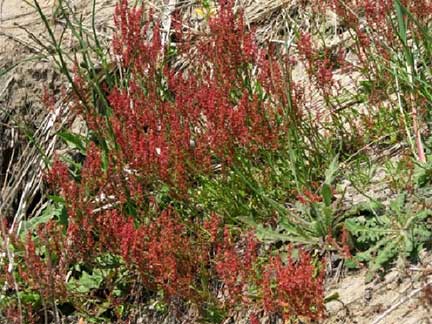 |
|
|
Spiraea douglasii var. douglasii
Douglas’s spiraea, Douglas’s hardhack, rose spiraea
British Columbia to Northern California
Family Rosaceae
Native
There is only one place I have found Douglas’s spiraea, and that is in a single patch at the base of Netarts Spit. This native shrub typically grows in thickets at low elevations, often in moist, wooded areas, and can be showy when in bloom. Flowers are bright pink to rose-colored, arranged in elongated panicles that form spires when the bloom is early, and often appear fuzzy because of protruding stamens. Leaves are alternate, oblong, toothed toward the outer end, and deciduous. The underside of a leaf is grayish with dense hairs. Leaves of another variety, S. douglasii var. menziesii, are sparsely haired underneath.
|
|
|
|
 |
 |
|
Stachys mexicana
Mexican hedge nettle, Mexican betony, Northwestern hedge nettle
British Columbia to California
Family Lamiaceae
Native
You can find the Mexican hedge nettle locally in moist, shaded areas, especially bordering the trails in Cape Lookout State Park. Mexican hedge nettle is a common coastal perennial that spreads by rhizomes, so it usually occurs in patches. Flowers are irregular, pink to rose, with a floral tube usually less than three-quarters of an inch long. Leaves are opposite lanceolate to elliptical, toothed, somewhat hairy, and stalked with petioles over a half inch long. Despite its name, it does not range into Mexico, but instead it was first described by a Spanish botanist.
|
 |
 |
|
Tellima grandiflora
Fringecups, bigflower tellima
Alaska to California
Family Saxifragaceae
Native
Blooming in the spring and early summer, especially in April and May, you can find fringecups along Netarts roadsides, particularly along the east side of Netarts Bay. It likes moist, somewhat shaded areas. Native to the Pacific Northwest, this rhizomatous perennial has numerous small flowers on an erect raceme. The flowers range in color from greenish white to pink to red, each with five deeply incised petals, making the flowers fringed. Leaves are heart-shaped, notched, palmately veined, and hairy.
|
|
|
 |
 |
|
Trifolium pratense (probably)
Red clover
Alaska to California, almost all of North America
Family Fabaceae
Non-native
Red clover, originally from Europe, has become naturalized to North America, and good examples can be found in the campground at Cape Lookout State Park where I have seen it up to a foot tall. It grows best on well drained soils, but will tolerate wet conditions. It is generally a biennial. Flower heads are pink to deep magenta, and have no involucre. The inflorescence is often sessile but may have a very short peduncle, up to a half inch long. The uppermost leaves may be associated with red-veined, bract-like stipules. The plant is hairy. Leaves are elliptical, often colored with a V-shaped lighter patch. Extracts of red clover are often used in folk and herbal medicines.
|
 |
 |
|
Trifolium wormskjoldii
Marsh clover, springbank clover, cow clover
British Columbia to Mexico
Family Fabaceae
Native
We have numerous clovers in our area, but one you will see along the shoreline is the perennial marsh or springbank clover, its common name indicating that it thrives in moist places, such as marshes and salt marshes. This showy pink to purple native clover is distinguished from most other local clovers by having an involucre, a circle of bracts at the base of the flower head. The leaves are trifoliate (three leaflets) although rarely, if you are lucky, you may find four. Marsh clover has white, fleshy and eatable rhizomes that were an important food for native peoples. You can see marsh clover near at Cape Lookout Sate Park, many places along Netarts Bay, near Fall Creek and around freshwater seeps between Netarts and Oceanside. Its specific name is also spelled wormskioldii, with an “i” in place of the ”j”.
|
 |
 |
|
Vaccinium ovatum
Evergreen huckleberry, California huckleberry
British Columbia to California
Family Ericaceae
Native
One of the favorite and most attractive of the local shrubs is the Evergreen Huckleberry, Vaccinium ovatum, common to the Coast mountain range and western Cascades. It is generally a shade tolerant plant that prefers sandy soil and forms a dense understory in pine, Douglas fir, cedar and Sitka spruce forest. It has thick leathery leaves that are shiny on the upper surface, serrated along the edges, and arranged in an alternating pattern of reddish stems. In the spring, new growth is an orange brown that turns bright then dark green as it matures. Spring growth is flowered with clusters of fragrant pink to white bell-shaped blossoms near the tip of each branch that develop into tasty berries in the late summer and fall and are eaten by a variety of birds and mammals. They were enjoyed by early Indians who often dried them into cakes for winter.
The Evergreen Huckleberry come in two varieties, one with shiny, purplish to black berries (Vaccinium ovatum ovatum) and the other with bluish fruit having a glaucous or waxy-looking surface (Vaccinium ovatum saparosum). You will find both varieties growing next to each other, but never with the two types of berries on the same bush. The glaucous variety is said to have the better flavor, but I have not noticed much difference. Both are delicious and are made into pies, coblers, jams, jellies, and syrups. They are high in vitamin-c, and like their relative, blueberries, have high levels of the antioxidant pigment anthocyanin. The berries can be picked from August into November (sometimes into December, depending on the weather). The foliage is harvested for floral arrangements and Christmas decorations.
|
 |
 |
|
Vaccinium parvifolium
Red huckleberry, red whortleberry
Southeast Alaska to California
Family Ericaceae
Native
Another tasty huckleberry native to western Cascades and the Coast Range, though not as plentiful between the Capes as the evergreen huckleberry, is the red huckleberry. Growing mostly at low elevations in or near our coniferous forest, it does well in acidic, loamy soil, and on rotting logs and stumps. Flowers, like those of the evergreen huckleberry, are bell-shaped, pendent, and greenish-yellow to pink, but there is only a single flower per leaf axil. Leaves are alternate, light green, finely serrated when young, but entire when mature. Stems are angled, ribbed, and decorated with small red buds. Fruits are bright red berries that were a staple of native peoples who ate them raw, cooked into sauces, dried and pressed into cakes, or stored in oil or fat. Since they resemble salmon eggs, they were also used as fish bait.
|
|
|
 |
 |
|
Vicia nigricans var. gigantea
Native giant vetch
Alaska to California
Family Fabaceae
Native
Vicia sativa var. sativa
Cultivated vetch or tare
British Columbia to California, Eastern States
Family Fabaceae
Non-native
There are several vetches along our coast, two of which are the native giant vetch (formerly Vicia gigantea) and the cultivated vetch or tare, Vicia sativa, an escaped introduction from Europe. A good example of the perennial giant vetch covers the hillside next to the beach just north of Happy Camp, but before you reach the wooden steps leading up to the Capes Community. It is a creeping plant that spreads into patches two to three feet deep, its tendrils grasping twigs and other plants for support. Pink and yellowish-white flowers line one side of a long, compound peduncle that stands upright from the main stem. The flowers develop into pods with seeds. Like all vetches, the leaves are pinnately compound, the leaflets opposite. Giant vetch has 16 or more leaflets, the ends of which are cuspidate, that is rounded on the end but with a short, sharp tip. Cultivated vetch is an annual with colorful violet flowers that are sessile, not on an elongated peduncle, and its leaflets, 6 to 14 in number, have ends that are retuse, a shallow notch on a rounded apex. This plant can be seen growing near the playground of the Capes Community.
|
 |
 |
 |
 |
 |
 |
 |
 |
 |
 |
 |
 |
 |
 |
 |
 |
 |
 |
 |
 |
 |
 |
|
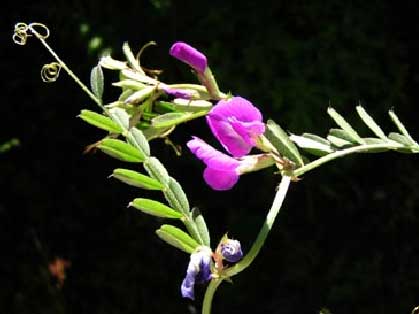 |
|
|
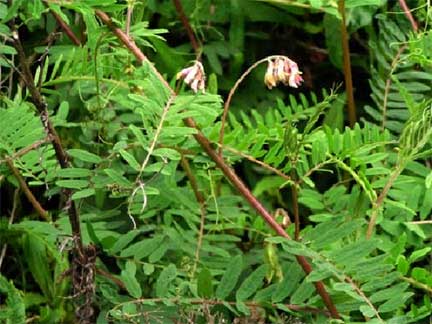 |
|
|
|
|
|
Giant vetch, Vicia nigricans Cultivated vetch, Vicia sativa
|
|
|
|
Corydalis scouleri
Scouler’s corydalis, Scouler’s fumewort
Southern British Columbia to Oregon
Family Fumariaceae
Native
A member of the bleeding heart family, the delicate-looking perennial with its showy pink flowers grows in shaded woods in the Coast Range and western Cascades. The specimen pictured here was found along the trail leading south and up the mountain from the Cape Lookout State Park campground. The plant is hairless but glaucous, having waxy coating that can be rubbed off. The flowers, arranged in a terminal spike-like cluster, are irregular, each with a long, sac-like spur that points upward. Leaves are alternate and pinnately divided two to four times with lobes that are spatulate to oblong. The plant spreads by rhizomes. The generic name comes from the Greek word “korydallis or korydalos” meaning a plant with a flower spur resembling the spur of a lark. The specific name is after John Scouler who explored the Pacific Northwest with the botanist David Douglas in the early 1800s..
|
|
|
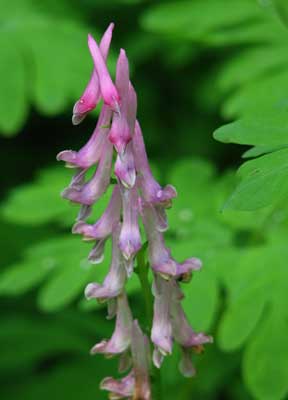 |
|
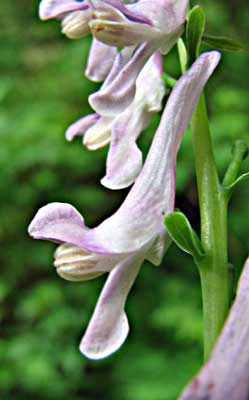 |
|
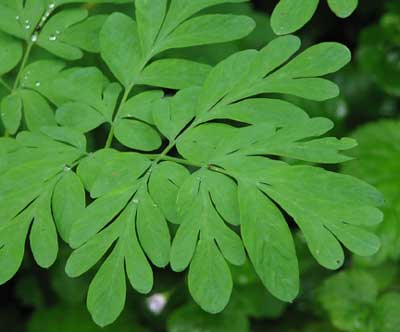 |
|
|
|
Montia parvifolia
Littleleaf montia, moisture-loving montia, streambank spring beauty
Alaska to Califonia, other northwestern states and provinces
Family Portulacaceae
Native
Sometimes called Claytonia parvifolia, this succulent is common on moist, shaded sites along stream banks, coastal cliff sides, upper beaches, and meadows. This one was growing on the cliff side above Lost Boy Beach. Flowers have white to pink petals, each with a small clef at the end, and two sepals. Leaves are somewhat succulent, most arranged in rosettes around the base of the plant. Basal leaves are lanceolate to elliptic; stem leaves are narrower and alternate. The plant spreads by both rhizomes and stolons. Montia is named after Italian botanist Giuseppe Montia, and parvifolia is from Latin for “small leaf”.
|
|
|
|
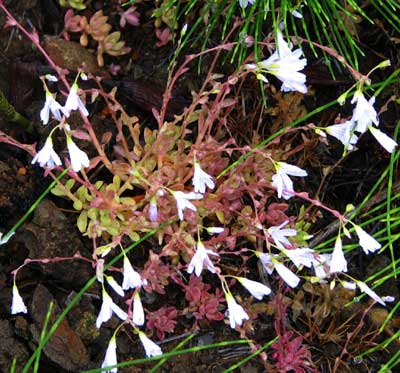 |
|
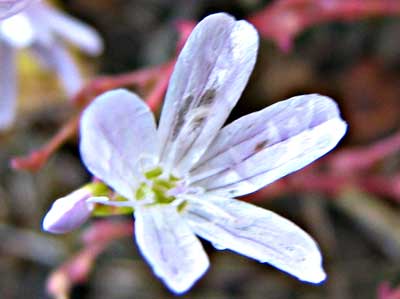 |
|
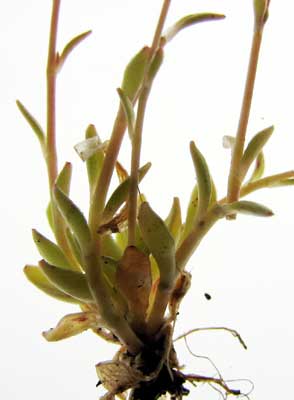 |
|
|
|
Click here to Return to Flowers - Page One
Click here for the Glossary
Click here for the References
Click here for the Introduction
Click here for Whitish Flowers
Click here for Yellowish Flowers
Click here for Bluish Flowers
Click here for Greenish Flowers
|
|
|
|
|
|

